Visible six pack abs are often seen as the pinnacle of physical fitness and aesthetic appeal. They are a result of two main factors: muscle development and low body fat percentage.
Firstly, the rectus abdominis muscle, which forms what we commonly call the “six pack,” is present in everyone. By performing core strengthening exercises like crunches, leg raises, and planks, you can develop and strengthen this muscle. Consistent and targeted workouts can increase the size and definition of the rectus abdominis.
However, muscle development is only one part of the equation. To make the six pack visible, you need to have a low enough body fat percentage for the muscles to show. This is where many people face challenges. Genetics play a significant role in how and where our bodies store fat. Some people naturally store more fat around their midsection, which can make it more difficult for them to reveal their abs, even if they have a strong core.
Diet is crucial in this regard. Even with the best workout routine, if your diet isn’t on point, it’s unlikely you’ll achieve that coveted visibility. Reducing calorie intake, eating nutrient-dense foods, and monitoring macronutrients can help in shedding the layer of fat that hides the abs.
That said, it’s important to note that not everyone will be able to achieve the same level of leanness necessary to show a six pack. Factors like age, hormones, and genetics can influence one’s ability to reduce body fat to such levels. Additionally, for some, achieving and maintaining such low body fat percentages might not be healthy or sustainable in the long run.
While everyone has the rectus abdominis muscle and can develop it through exercise, achieving visible six pack abs requires both muscle development and a low body fat percentage. It’s possible for many, but various individual factors determine the ease and feasibility of this goal. Regardless, a strong core is beneficial for overall health and functionality, even if it’s not always visible.

